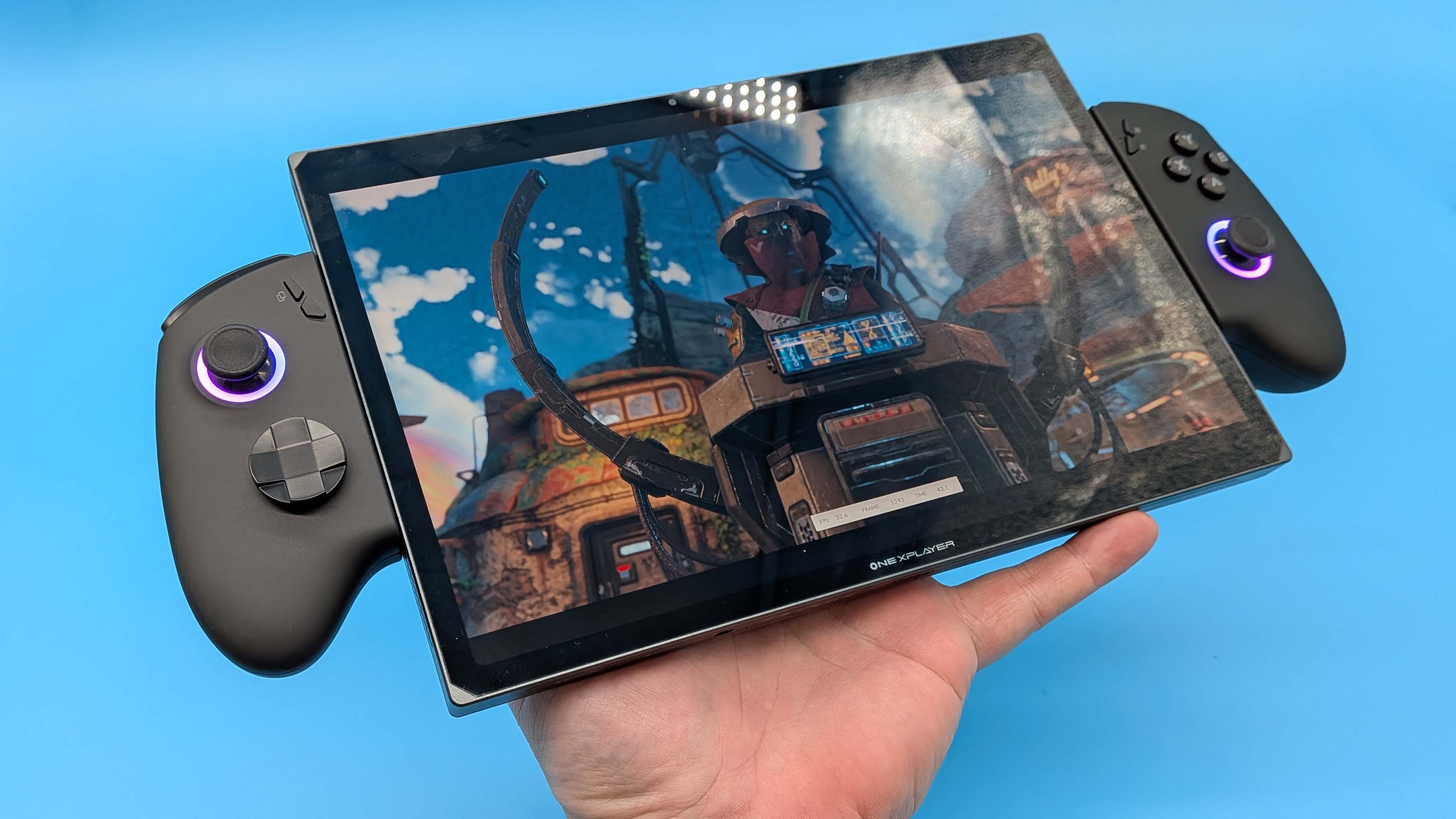Supreme Commander 2 - PC Gamer UK's Co-op Game Of The Year
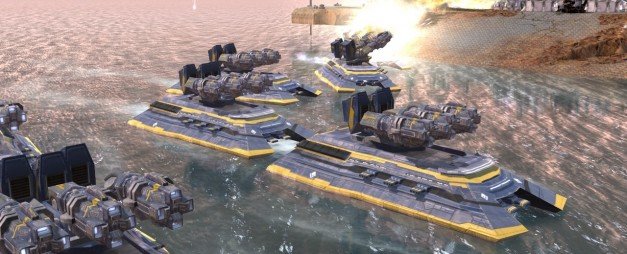
Why RTS sequel Supreme Commander 2 has gone from 'good' to my 'Game Of The Year.'
If you loved Supreme Commander, you probably didn't like Supreme Commander 2. And if you didn't like Supreme Commander, you probably didn't play Supreme Commander 2. It was an awkwardly pitched sequel: a game that solved the accessibility issues of the first game, bought primarily by people who didn't want them solved.
Since its release, though, sustained precision fire from the Tech 3 Patch Cannon has knocked SupCom 2 into impressive shape: a large-scale RTS with smart economy management, but easy to play and understand at the basic level. It still dominates PC Gamer's lunchtimes, every game leads to apocalyptic clashes of plasma-spitting tungsten monstrosities, and it's become my favourite title of 2010.
Not that I'm suggesting anyone play the campaign: don't. Play a one-off game against the Easy AI to get started. Then get some friends in and play the way we do in the office: cooperatively. Our last big game was six PC Gamer writers versus two top-level AIs with massive resource bonuses, and it got a little out of hand.
Playing field
The map is Desert Canyon, a huge dust bowl surrounded by tall mesas with mass points on top of them for anyone with jetpacks, transports or teleporters. The outer edges are a forest of these, while the centre is a huge open expanse.
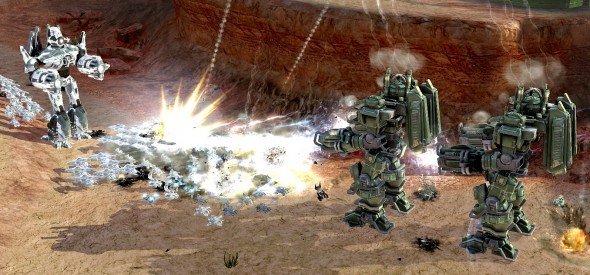
At the top of the map, we have the two Cheating AIs. They produce resources 200% faster than us, their units build twice as fast, and they level up in combat at a ridiculous rate. Below them, clockwise around the dust bowl, we have: Tim, who doesn't play much SupCom but has joined in to try the DLC. Rich, who plays Illuminate and likes to teleport giant humanoid robots across the map. Graham, who builds meticulously neat, self-sufficient bases, then masses artillery and planes. Me, a Cybran obsessed with making my experimentals invincible with hundreds of mobile shields. Tom Senior, who likes to spread his base out and make outposts. And Jaz, who makes land units then ferries them about in air transports.
Damage control
The game starts, and within a few minutes Tim and Jaz are under attack. They're closest to the AIs, and the onslaught is tough to defend. Jaz builds waddling Harvog assault bots, loads them into large transports, then uses the new Illuminate air teleport ability to zap them directly into the enemy base. I don't have time to check up on how that works out, but pretty soon Jaz's commander goes nuclear and his whole base is levelled, so I'm guessing not well. He's out, and Tom Senior is next in line.
Keep up to date with the most important stories and the best deals, as picked by the PC Gamer team.
Tim takes heavy damage too, but isn't quite eliminated: the AI smash through his base, but leave a few buildings standing and just move on, down towards Graham. They often assign low priority to finishing you off: once they're sure you can't win, they won't risk damaging their units more than they have to by attacking your last defensive positions. Tim stomps his commander down to Rich's base and hides among the power generators, using his remaining mass to build artillery.
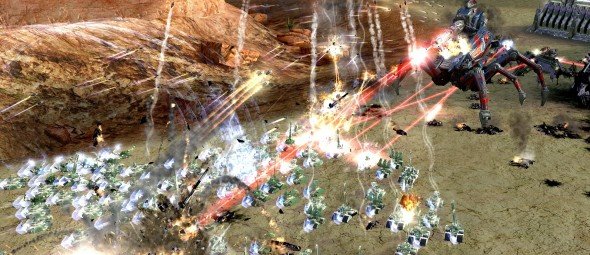
Rich himself gets to work on Colossi: vast bipedal deathbots that fire white-hot lasers from their faces. Meanwhile, Graham is building enough energy generators – in a perfect grid – that he'll never need to leave his base. Converting energy to mass is inefficient, as Einstein pointed out, but it means avoiding the risk of expanding.
From the moment the game starts, everything I do is geared towards building a Monkeylord as soon as humanly possible. It's a laser death hose on spider legs, and it's the size of a city block. It's also the toughest unit SupCom 2 has ever seen, and the idea of one of those surrounded by Adaptor shields makes me giddy.
This is why I particularly love Supreme Commander 2 in co-op. To me, making big land units and lots of little shield generators seems like the obvious way to play. To Graham, never leaving his base seems natural. Rich just likes one unit so much he's going to build it forever. So you have this huge map with every player working towards their own masterpiece of base construction and unit composition. They're not scouting the enemy and then mechanically building the counter to whatever they see – it's much more about personal preference and the way you like to fight.
Deadly swarm
Tom Senior is in trouble – tanks, missile launchers and mobile artillery are swarming his Megalith outpost. The Megaliths themselves are doing their best with their long-range lasers, but he's losing buildings now. Luckily, my Monkeylord is done.
This is how you want to try out a unit: against a swarming field of tanks. Its giant laser pops them like bubblewrap, so fast he could write his name in their ranks if his name was a bit shorter than 'Monkeylord'. Soon we're holding back the hordes reliably enough for me to get my commander down there, and start putting up artillery to pressure the AI's forward base, built in the remnants of Jaz's.
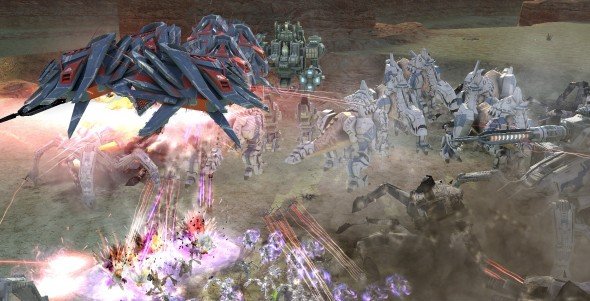
On the opposite side of the ravine, Rich's Colossi are trudging into the Space Temple: a giant spire that can teleport any unit extraordinary distances across the map. They're jumping almost all the way to the enemy base, and coming face-to-face with SupCom 2's other vast humanoid killing machines: King Kriptors. The Kriptors fire scorching flame from their fists, the Colossi fire their facelasers, and it's almost as if titanic things are in some way clashing.
Back at Tom's base, the enemy hordes are getting more serious. Kriptors are showing up, with pet Cybrannosaurus Rexes. They smash up my artillery and almost all of Tom's base before I can get Soul Ripper gunships out to deal with them. My Monkeylord is nigh invincible, but even he can't kill units of that size before they blow up whatever they like.
Then, the ultimate disaster strikes us all: the end of lunchbreak. This is bad. At the time, this match wasn't strictly work-related, but it was far too exciting to abandon. So instead, I dialled it down to the slowest game speed, and we all pressed Alt + Tab and got on with writing things and shouting at games companies. For the rest of the day, the game ran at a glacial pace in the background, our empires running on autopilot while the AI hordes built up around us.
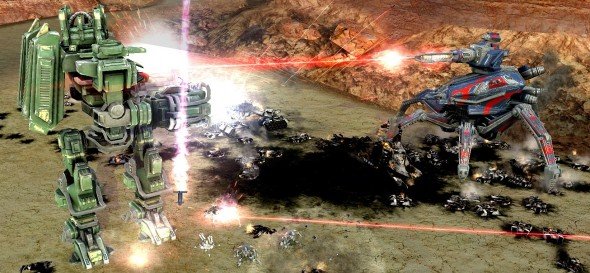
This never used to happen. At launch, a game of SupCom would almost never go over 40 minutes, so it fitted comfortably into a lunchbreak. But Gas Powered have wisely leaned towards larger and larger maps with the content they've added, both free and in the paid DLC. Super units such as the Monkeylord are longer-term projects to build, and longer-term challenges to destroy.
When we switched back at the end of the day, the news wasn't good. Tom, Tim and Jaz had all been eliminated, and Graham's game had crashed out, blowing up everything he owned. Only Rich and I remained: he with 14 Colossi milling around in his base, I with five Monkeylords clustered in mine. My Commander and original Monkeylord were still alive in the ruins of Tom's, but as I checked up on them, more enemy experimentals emerged from the fog of war. Oh hell.
Back to base
Five Monkeylords. Six dinosaurs. A Kriptor. Two Megaliths. A hundred tanks. I had my commander top off the Monkeylord's health, then spent some research points to jumpjet him the hell out of there and back to the relative safety of my base.
Trying to get a better handle on how screwed we were, Rich built an Illuminator: a new structure that can momentarily reveal almost the entire map. It's an eye-opening overview of the battle as it stands. And when he finally charged and activated it, it revealed a sea of horrors. This vast empty desert was now teeming with robotic death. Uncountable Monkeylords. Hundreds of Kriptors. Fleets of flying fortresses. Dozens of Soul Rippers.
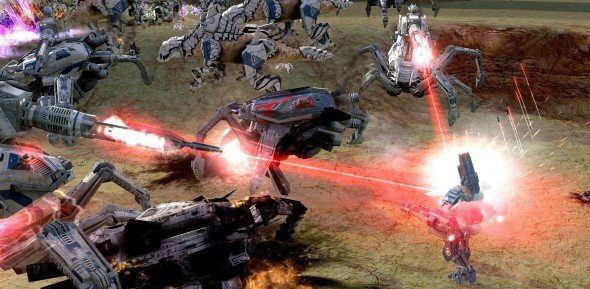
It was pointless to try and fight it all. Our only hope was a single joint strike on one of the AI's now heavily shielded bases. I unlocked air transports, picked up my Monkeylords and flew them over to Rich's base. He set his teleporter destination as far as it would go towards the green base, and marched his 14 Colossi into it single file. In about eight minutes – it's a big map – we were in position. Even with our ridiculous combined force, wading into that base was an explosive slog. I had to back us up with Bomb Bouncers to defend against artillery, and Soul Rippers to deal with the enemy's endless flying fortresses.
Eventually, we punched through. As Rich's Colossi finally made it up the central ramp to the base, I flew my Monkeylords up the cliffs on either side to attack his Quantum Disruptor artillery directly. His fully upgraded, shielded, self-repairing base finally crumbled. We'd lost nearly everything, but we'd taken this one base. We'd destroyed one of the commanders. And we'd proved, in theory at least, that we could win.
Then we looked at the enemy forces again, and decided we might be better off dead. Ctrl + K sets anything you've selected to selfdestruct in five seconds, so if you've selected your buildings, units, engineers and commander all at once, it's about the only thing more spectacular than the battle we just had. It seemed like a fitting end.

